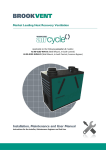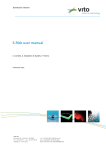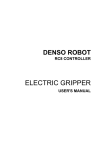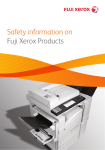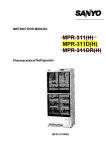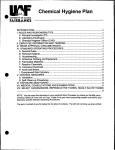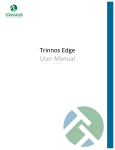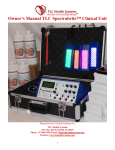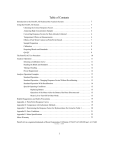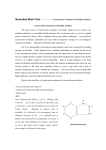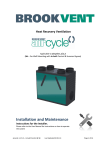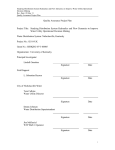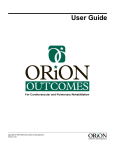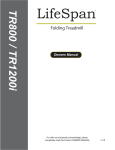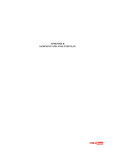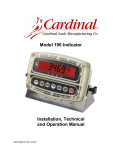Download Owner`s Manual - Amazon Web Services
Transcript
Fl uor escentLampCr ushi ngSyst em www. Ai r Cycl e. com |800. 909. 9709 |i nf o@Ai r Cycl e. com Purpose and Function of Manual The owner’s user manual contains all essential information for the user to make full use of the information on the . This manual includes: • Description of the Standard Safety Symbols and Safety Systems used. • System Functions • Assembly & Operations • Maintenance & Trouble Shooting • Parts & Accessories • Reference Materials & Forms • Step by Step Procedures Read all manuals included with this product carefully. Be thoroughly familiar with the controls and the proper used of the equipment. Serial Number Model Number: 333-200-120 or 333-200-240____ Serial Number: ______________________________ Date of Purchase: ___________________________ The serial number will be found on a label attached to the control box. You should record both serial number and date of purchase and keep in a safe place for future reference. US-800.909.9709 Outside US-708.344.7860 Fax: 866.909.6725 12/04/2014 800.909.9709 www.AirCycle.com [i] Table of Contents Purpose and Function of Manual .............................................................................................. i Table of Contents.....................................................................................................................1 Important safety instructions................................................................................................ 2,3 Machine & Control Panel Diagrams ..................................................................................... 4-6 Bulb Eater® 3 Parts List ............................................................................................................7 Bulb Eater® 3 Dimensions ........................................................................................................8 Assembly & Operations Bulb Eater® 3 Assembly Instructions ................................................................................... 9,10 Bulb Eater® 3 Operating Procedures ................................................................................. 11,12 Recycling Full Drums ..............................................................................................................14 Maintenance & Trouble Shooting Drum Change Procedures ......................................................................................................13 Filter Replacement Procedures ........................................................................................ 16-18 Spinner Replacement Procedures ..........................................................................................18 Troubleshooting the Bulb Eater® 3 ........................................................................................19 Operating Tips & Frequently Asked Questions ................................................................. 19-21 Parts & Accessories Replacement Parts & Accessories ..........................................................................................22 Parts List ................................................................................................................................23 Maintenance & Trouble Shooting Pickup Request Form .............................................................................................................15 Mercury Information .............................................................................................................24 Mercury Standards ................................................................................................................29 Warranty Information ............................................................................................................30 800.909.9709 www.AirCycle.com [1] IMPORTANT SAFETY INSTRUCTIONS ATTENTION! Inspect Bulb Eater® 3 (referred to as BE3) prior to any use. Check for external damage that might have occurred during Read all safety rules carefully before attempting to operate. Retain for future reference. DANGER! Never operate this unit when flammable materials or vapors are present because electrical devices produce arcs or sparks that can cause a fire or explosion. NEVER OPERATE UNATTENDED! transit. Be careful of moving parts. Report any damage Owner/User Responsibility: Warning information should be emphasized by the operator. If the operator is not fluent in the languages of the written manual, the manufacturer’s instructions and warnings shall be read to and discussed with the operator in the operator’s native language by the purchaser/owner, making sure that the operator comprehends its contents. *The BE3 can be operated outdoors in a dry covered environment, but MUST BE STORED indoors (when not in use) in a dry area!!* MACHINE SAFETY LABELS ON BE3 Danger indicates an imminently hazardous situation which, if not avoided, will resultpotentially in death or serious injury. Warning indicates a potentially hazardous situation which, if not hazardous situation if not avoided, could resultwhich, in death or avoided, could result in death or serious injury. avoided, could result in death or serious injury. Caution indicates a potentially serious injury. hazardous situation which, if not avoided, could result in minor or moderate injury.or avoided, could result in death Important indicates important serious injury. information that if not followed, may cause damage to equipment or operator. SAFETY SYMBOLS Warning, Keep Hands out of the Machine. Warning, Indicates Hazardous Voltage. Important, Hearing & Vision Protection. Important, Hand Protection Required. Read all manuals included with this product carefully. Be thoroughly familiar with the controls and the proper use of the equipment. Meets the following standards: UL 73: Issued: 2011/03/02 Ed: 10 UL Standard for Safety for Motor-Operated Appliances CAN/CSA C22.2 No. 68: Issue: 2009/09/01 Ed: 7 Motor-Operated Appliances 800.909.9709 www.AirCycle.com [2] IMPORTANT SAFETY INSTRUCTIONS When using an electrical appliance or machine, basic precautions should always be followed, including the following: READ ALL 11. Do not handle plug or machine with wet hands. 12. Close supervision is necessary when a machine is used near children. 13. Keep hair, loose clothing, fingers and all parts of body away from openings and moving parts. 14. Do not use without filters in place. May disperse fine dust particles into the air. 15. Turn off all controls before unplugging. 16. Do not use in areas where combustible liquids such as gasoline may be present. 17. Do not vacuum toxic, carcinogenic, combustible or other hazardous materials such as asbestos, arsenic, barium, beryllium, lead, pesticides or other health endangering materials. Specially designed units are available for these purposes. 18. Do not leave the cord lying on the floor when the machine is not being operated. It can become a tripping hazard. 19. Use special care when emptying heavily loaded drums. drums. 20. Always wear safety goggles and hearing protection when operating the machine. 21. STAY ALERT. Watch what you are doing and use common sense. Do not use the BE3 machine when you are tired, distracted or under the influence of drugs, alcohol or medication causing diminished control. INSTRUCTIONS BEFORE USING THIS APPLIANCE/MACHINE. WARNING 1. 2. 3. 4. 5. 6. 7. 8. 9. – TO REDUCE THE RISK OF FIRE, ELECTRIC SHOCK OR INJURY: Do not leave machine unattended when plugged in. Unplug from outlet when not in use and before servicing. Connect to a properly grounded outlet only. See Grounding instructions. Do not put machine in water or other liquid. Do not expose to rain – store indoors. Do not place or store machine where it can fall or be pulled into a tub or sink. Use only as described in this manual. Use only manufacturer’s recommended attachments. Do not use with damaged cord or plug. If machine is not working as it should, has been dropped, damaged, left outdoors or dropped into water, contact Air Cycle Corporation for assistance. Replace with specific part of machine in question. Do Not: pull or carry by cord, use cord as a handle, close a door on cord or pull cord around sharp edges or corners. Do not run machine over cord. Keep cord away from heated surfaces. Do not unplug by pulling on cord. To unplug, grasp the plug; not the cord. Do not put any object into openings. Do not use with any openings blocked; keep free of dust, lint, hair and anything that may reduce air flow. SAVE THESE INSTRUCTIONS WARNING – DO NOT LEAVE Bulb Eater ® 3 MACHINE UNATTENDED WHEN IT IS PLUGGED IN AND/OR OPERATING. UNPLUG UNIT WHEN NOT IN USE. GROUNDING INSTRUCTIONS This machine must be grounded. If it should malfunction or breakdown, grounding provides a path of least resistance for electric current to reduce the risk of electric shock. This machine is equipped with a cord having an equipment-grounding conductor and grounding plug. The plug must be inserted into an appropriate outlet that is properly installed and grounded in accordance with all local codes and ordinances. and has a plug that looks like the plug illustrated in the sketch. A temporary adapter that looks like the adapter illustrated in the sketch may be used to connect this plug to a 2-pole receptacle, as shown, if a properly grounded outlet is not available. The temporary adapter should be used only until a properly grounded outlet (sketch) can be installed by a qualified electrician. The green colored rigid ear, lug or the like extending from the adapter must be connected to a permanent ground such as a properly grounded outlet box cover. Whenever the adapter is used, it must be held in place by a metal screw. WARNING – IMPROPER CONNECTION OF THE MACHINE GROUNDING CONDUCTOR CAN RESULT IN A RISK OF ELECTRIC SHOCK. CHECK WITH A QUALIFIED ELECTRICIAN OR SERVICE PERSON IF YOU ARE IN DOUBT AS TO WHETHER THE OUTLET IS PROPERLY GROUNDED. DO NOT MODIFY THE PLUG PROVIDED WITH THE MACHINE – IF IT WILL NOT FIT THE OUTLET, HAVE A PROPER OUTLET INSTALLED BY A QUALIFIED ELECTRICIAN. IN CANADA, THE USE OF A TEMPORARY ADAPTER IS NOT PERMITTED BY THE CANADIAN ELECTRICAL CODE. Make sure that the machine is connected to an outlet having the same configuration as the plug. No adapter should be used with this machine. This machine is for use on a nominal 120-vac or 240-vac power, 800.909.9709 www.AirCycle.com [3] Control Panel LCD Screen E-Stop Stop Button Start Button Dust Cap w/ USB Plug AC Receptacle 800.909.9709 www.AirCycle.com [4] The The Bulb Eater® 3 is capable of crushing any size linear/straight fluorescent lamp, u-tube fluorescent lamp, and compact fluorescent lamps. Cyclone Assembly Crusher Motor (1st stage filter system) Entry Tube (Not to scale) Brass Plug Assembly (At linear lamp entry) Chute Safety Cover (for U-tube/CFL chute) Airlock Assembly Control Panel (see page 4 for details) Lid Assembly Vacuum & Filter (contains 2nd & 3rd stage filters) Carbon Canister Filter (contains 4th & 5th stage filters) Not pictured 48” Entry Tube Spinner Assembly 2nd Stage Filter (located on underside of lid) 800.909.9709 www.AirCycle.com 3rd & 5th Stage Filter CFL/U-Tube Chute (attaches on U-Tube Flange) [5] The with CFL/U-Tube Chute The Bulb Eater® 3 is capable of crushing any size linear/straight fluorescent lamp, u-tube fluorescent lamp, and compact fluorescent lamps. Cyclone Assembly Crusher Motor CFL/U-Tube Chute (1st stage filter system) Brass Plug Assembly (At linear lamp entry) Control Panel (see page 4 for details) Airlock Assembly Lid Assembly Vacuum & Filter (contains 2nd & 3rd stage filters) Carbon Canister Filter (contains 4th & 5th stage filters) Not pictured 48” Entry Tube 2nd Stage Filter Spinner Assembly (located on underside of lid) 800.909.9709 www.AirCycle.com [6] 3rd & 5th Stage Filter The Parts Included w/ Machine ® The Bulb Eater 3 Parts List: 1. Airlock Assembly w/ motor (120v or 240v) 2. Lid Assembly 3. Brass Plug Assembly 4. Carbon Canister Assembly 5. Cartridge Filter 6. Chute Safety Cover 7. Control Panel Assembly 8. Crusher Motor, 1/5 Horsepower, 2-amp, 120v 9. Cyclone Assembly 10. HEPA Filter 11. Lid Open Sensor Assembly 12. Locking Ring & Bolt 13. Spinner Assembly 14. Vacuum Body Assembly 15. Vacuum Motor 120v or 240v 16. Plug Assembly 17. Safety Gloves (2 Pairs) 18. Safety Glasses (2 Pairs) 19. Ear Plugs (2 Pairs) 20. 48” T 12 Entry Tube 21. USB Drive ® 22. Bulb Eater 3 Owner’s Manual Quantity 1 1 1 1 1 1 1 1 1 2 1 1 1 1 1 1 2 2 2 1 1 1 *Other accessory parts are available from the parts list. ® The Bulb Eater 3 Parts List for Assembly: ® 1. Bulb Eater 3 Lid w/ Assemblies 2. Carbon Canister Assembly 3. Clamps for Cyclone Assembly 4. Clamp for Carbon Canister 5. Cyclone w/ Vacuum Lid Assembly 6. O-Ring for Cyclone Assembly 7. O-Ring for Carbon Canister 8. 5g Mini-Tube of Silicone Grease 800.909.9709 www.AirCycle.com Quantity 1 1 2 1 1 2 1 1 [7] The Dimensions 25” (635 mm) mm) 39” (991 mm) 54” (1372 mm) Note: *10’ L x 5’ W x 8’ H area required to use the machine and crush 4 ft. lamps. *13’ L x 5’ W x 9’ H area required to use the machine and crush 8 ft. lamps. 800.909.9709 www.AirCycle.com [8] The Assembly Instructions What You’ll Need: 55-Gallon Drum 15/16” wrench or socket Safety Glasses Safety Gloves Instructions: 1. Attach the plug assembly to the handle and install the handle to the lid assembly using (2) 1/4”-20 x 3/4” screws. Figure 1 ® 2. Mount the Bulb Eater 3 onto the drum, tightening the bolt ring with a 15/16” wrench or socket. Figure 2 3. Apply silicone grease on the two O-rings and place an O-ring and a clamp on the airlock assembly & an O-ring and a clamp on the mounting flange for the installation of the cyclone assembly. Figure 3 nd 4. Place the 2 stage cartridge filter into the upper housing of the vacuum housing assembly. Figure 4 5. Place the cyclone assembly on the mounting flanges with the lid assembly attached to it, and place onto the upper housing which holds the cartridge filter. Figure 5 1 FIG. 1 6. Fasten the lid clips on the vacuum lid and secure. Tighten the clamp on the airlock assembly to the cyclone assembly until it’s snug. Tighten the clamp on the cyclone flange to the cyclone assembly all the way until it’s tight. Now re-tighten the clamp on the airlock assembly to the cyclone assembly all the way. Figure 6 Note: This will allow the cyclone assembly to be installed correctly & air tight. 7. Apply silicone grease to the O-ring and place the O-ring and clamp on the carbon canister. Figure 7 Hold the carbon canister up to the lower housing and tighten the clamp all the way (2 persons required). Figure 8 2 FIG. 2 8. Place the 3 caps on the clamps. Figure 9 9. Unscrew the plug assembly and install the entry tube. Figure 10 10. Finally, connect the power cord to the control panel on ® your Bulb Eater 3 and plug it into an outlet. Figure 10 3 IMPORTANT: Electrical Requirements 120V AC / Single Phase / 50HZ or 60HZ OR 240V AC / Single Phase / 50 HZ or 60HZ Must be protected by a minimum of 15 amp fuse or circuit breaker ® Watch the Bulb Eater 3 Training Video at: www.aircycle.com/videos FIG. 3 800.909.9709 www.AirCycle.com [9] 5 4 FIG. 5 FIG. 4 7 6 FIG. 6 FIG. 7 FIG. 8 9 8 FIG. 10 FIG. 9 800.909.9709 www.AirCycle.com [10] 10 Operating Procedures for Linear Lamps WARNING – DO NOT TAMPER WITH ANY ELECTRICAL CONTROL DEVICES ON THIS MACHINE Before Operating the Bulb Eater® 3 • Communicate/understand potential hazards by having operators review pages 24-29 of this manual and complete online training program at www.BulbEater3Training.com Note: The Bulb Eater® 3 machine is inoperable until key personnel have completed this online training program. Details to activate the Bulb Eater® 3 machine will be provided immediately upon completion of the program • Before crushing, label drum as containing Mercury (D009) and as either Hazardous Waste or Universal Waste depending on your state requirements • Crush lamps in a well-ventilated area • Wear safety glasses, protective gloves, and ear protection • Screw in entry tube for crushing linear lamps • Remove rubber plug from top of entry tube • Crush only linear fluorescent lamps 1. Plug the machine in & release the E-STOP button. The machine will go through 3 LCD display functions – Stopping, Dumping, Ready. 2. Take the plug out of the entry tube. 3. Press the START button. When the LCD screen displays ready. 4. Insert the linear lamp into the entry tube and then let go. Do not force the lamp down the entry tube. 5. The machine will time out when the cyclone counter zeros out, followed by 3 LCD display functions – Stopping, Dumping, Ready. 6. To continue crushing press the START button. 7. After crushing, press the STOP button to stop the crusher motor. The machine will go through 3 LCD display functions again – Stopping, Dumping, Ready. 8. When the LCD display indicates “Ready”, press the E-STOP button and seal the entry tube. Figure 1 When the machine is not in use, make sure that all openings are sealed (sealed entry tube and CFL chute may remain on the machine when not in operation). 9. Before removing lid: Let the machine sit OFF for at least 15 minutes after the dump cycle is done to allow dust to settle before opening the lid during drum change. Notes: 1. Pressing the STOP button must be completed before pressing the E-STOP button when finished crushing, this will allow the powder to be dumped out of the cyclone into the drum. 2. When crushing linear lamps, insure that the CFL/U-Tube chute is removed and the safety cover is installed. ATTENTION: Drum MUST be kept closed at all times FIG. 1 800.909.9709 www.AirCycle.com [11] Operating Procedures for CFL’S/ U-Tube Lamps WARNING – DO NOT TAMPER WITH ANY ELECTRICAL CONTROL DEVICES ON THIS MACHINE Before Operating the Bulb Eater® 3 with CFL/U-Tube Chute • Communicate/understand potential hazards by having operators review pages 24-29 of this manual and complete online training program at www.BulbEater3Training.com Note: The Bulb Eater® 3 machine is inoperable until key personnel have completed this online training program. Details to activate the Bulb Eater® 3 machine will be provided immediately upon completion of the program • Before crushing, label drum as containing Mercury (D009) and as either Hazardous Waste or Universal Waste depending on your state requirements • Crush lamps in a well-ventilated area • Wear safety glasses, protective gloves, and ear protection • Attach and secure the CFL/U-Tube chute by first removing the safety cover. Insert the CFL/U-Tube chute and be certain to engage the three latches. Figure 1 (CFL/U-tube chute should be attached whenever machine is crushing CFL’s/U-Tubes). Linear entry tube can remain on the machine as long as it is plugged. • If crushing CFLs: open CFL chute safety cover and seal entry tube or entry tube hub • Crush only U-Tube lamps or CFL bulbs 1. Plug the machine in & release the E-STOP button. The machine will go through 3 LCD display functions – Stopping, Dumping, Ready. 2. Remove the chute safety cover to install the CFL/U-Tube chute. Place the plug into the entry tube. 3. Press the START button. When the LCD screen display ready. 4. Crush Lamps. a. U-Tube Lamps: i. Make sure that the CFL chute safety cover is closed. ii. Insert the u-tube lamp into the chute and then let go. Do not force the lamp down the chute. b. CFLs Bulbs: i. Open safety cover ii. Place bulbs in the CFL chute individually (larger bulbs) or in small batches. 5. The machine will time out when the cyclone counter zeros out, followed by 3 LCD display functions – Stopping, Dumping, Ready. 6. To continue crushing press the START button. 7. After crushing, press the STOP button to stop the crusher motor. The machine will go through 3 LCD display functions again – Stopping, Dumping, Ready. 8. When the LCD display indicates “Ready”, press the E-STOP button, seal the top of the entry tube with the rubber plug then remove the CFL/U-Tube chute and attach the chute safety cover: (Figure 2) When the machine is not in use, make sure that all openings are sealed (sealed entry tube and CFL chute may remain on the machine when not in operation). 9. Before removing lid: Let the machine sit OFF for at least 15 minutes after the dump cycle is done to allow dust to settle before opening the lid during drum change. Note: Pressing the STOP button must be completed before pressing the E-STOP button when finished crushing, this will allow the powder to be dumped out of the cyclone into the drum. ATTENTION: Drum MUST be kept closed at all times 3 Latches 8 FIG. 1 FIG. 2 800.909.9709 www.AirCycle.com [12] Drum Change Procedures 1. Loosen the lid locking bolt & ring on the Bulb Eater® 3 machine and remove the lid locking ring on the spare lid. Figure 1 2. Lift the Bulb Eater® 3 machine straight up with the spare lid in hand. (requires 2 person for lid change) Figure 2,3 3. Immediately place the spare lid on the full drum to seal the vapor. Figure 4 4. Place the Bulb Eater® 3 Machine on the empty drum and tighten the locking ring. Figure 5 5. Place the lid locking ring on the lid with the full drum and tighten. Figure 6 Note: When this procedure is executed properly, the drum-open time should be less than 10 seconds. Figure 1: Figure 2: Figure 3: Figure 4: Figure 5: Figure 6: 800.909.9709 www.AirCycle.com [13] Recycling Full Drums Schedule a Recycling Pickup • Call Air Cycle at 800.909.9709 • Schedule a pickup online at www.aircycle.com/services • Use the “Pick-Up Request Form” (Page 15) to schedule your pick-up Air Cycle offers bulk pickup service to allow you to continue enjoying cost-effective recycling solutions after you have crushed your lamps, conserve your storage space, save money over other recycling solutions, and help keep our environment clean. With Air Cycle’s Crushed Lamp Bulk Pickups You Can: • Have large amounts of crushed lamps picked up nationwide • Recycle various types of universal waste with a single pickup (including batteries, ballasts, and electronics) • Track your recycling progress online 24/7 with online recycling reports • Certify your progress for regulatory or management review with Recycling Certificates 800.909.9709 www.AirCycle.com [14] Pick-Up Request Form Schedule a Pickup online at www.aircycle.com/services or call 800.909.9709 Pick-Up Request Form 2200 Ogden Avenue, Suite 100 • Lisle, IL 60532 Tel (800) 909-9709 • Fax (866) 909-6725 • www.aircycle.com Date: Generator Pick-Up Location Generator Billing Information Company: Company: Address: Address: City/State/Zip: City/State/Zip: Contact: Accounts Payable Contact: Contact E-mail: Accounts Payable Phone: Contact Phone: Accounts Payable E-mail: Contact Fax: EPA ID#: Alternate Contact/Phone: PO#: Transportation Requirements section is required. Failure to complete this section may delay the scheduling of service to your facility. A truck with a lift gate is required to pick up the material. Yes No Is there a forklift available to load the material onto the truck? Yes No The material will need to be manually loaded onto the truck. Yes No Yes No Replacement Containers: Quantity 55 Gallon Steel Drums Note: manpower charges for loading may apply A full size tractor-trailer can fit into the loading dock. 4' Fiber Drums 4' Lamp Boxes 8' Lamp Boxes Height and length restrictions for the loading dock are: 5 Gallon Poly Pails Where is the material stored within your facility:___________________________________ Available Loading Hours: _________________________ Failure to complete this section may delay the scheduling of service to your facility Material To Be Picked Up: Lamps: Quantity Batteries: 55 Gallon Drums of Crushed Lamps Mixed 55 Gallon Drums of Crushed CFL's Alkaline 4ft. or Less Fluorescent Lamps Lead Acid Weight The Material Is Packaged In: Quantity Steel Drums (55 Gallon) 5ft. - 8ft. Fluorescent Lamps NiCad 9ft. or More Fluorescent Lamps NiMH Cardboard Boxes U-Bend / Circular Lithium 4' Fiber Drums (185 count) Compact w/o Ballast 8' Fiber Drums (85 count) Compact w/Ballast Mercury Zinc Carbon HID (Mercury Vapor, Metal Halide, High-pressure Sodium) Ballasts: Shattershield / Coated Non-PCB Incandescent PCB 4' Fiber Drums (85 count) Poly Pails (5 Gallon) Weight Other: Total of Pallets: UV Other Waste for Recycling Pick Up: Office Machinery (E-scrap): Other Waste: Special Instructions: The marked material is to be properly identified and prepared for transportation and tender in accordance with all applicable statutes, ordinances, permits, rules and regulations of the Federal, State, and Local governments in whose jurisdiction such material originates, passes through, or is tendered for delivery (certify for declare) under penalty of perjury that the foregoing is true and correct. Do not place any extraneous material or liquids in the drum. Presence of these materials with the crushed lamp waste could result in very significant upcharges or potential return of the waste to your facility. All final counts will take place at the end destination processing facility. Please fill out this form completely and fax it to 866-909-6725 or e-mail to [email protected] Have you tried our online services? Visit us at AirCycle.com/services to schedule your pickup online today! 800.909.9709 www.AirCycle.com [15] Filter Replacement Directions 1st stage Cyclone Filter will never need to be changed. 2nd stage Cartridge Filter required to be changed when the fault code 13 is displayed on the LCD screen. 3rd stage HEPA Filter required to be changed when the fault code 11 is displayed on the LCD screen. 4th stage Carbon Filter: The carbon filter will require changing when filter life times out (1,500 hrs). Fault code 01 will be displayed on the LCD screen. 5th stage final HEPA Filter required to be changed when the fault code 09 is displayed on the screen. Spent Filters must NEVER be left exposed. Spent filters must either remain in the vacuum housing attached to the unit, be sealed in a full drum of crushed lamps, or bagged in a zip-top bag to avoid mercury release. DO NOT DISPOSE OF FILTERS IN THE TRASH • Communicate/understand potential hazards by having operators review pages 24-29 of this manual and complete online training program at www.BulbEater3Training.com • Confirm that the Bulb Eater® 3 is clearly “off” and not operating. • The operator must wear safety glasses and gloves when changing any of the three Bulb Eater® 3 filters Replacing the 2nd Stage Cartridge Filter: 1. 2. 3. 4. Remove the lid from the upper housing of the vacuum body. Figure 1 Remove the used 2nd stage cartridge filter from the upper housing. Figure 2, Figure 3 Replace the new 2nd stage cartridge filter in the upper housing. Figure 3 Replace the lid on the upper housing of the vacuum body and secure with the 4 clips. Figure 4 Figure 2: 1 2 Figure 1: 4 Figure 3: 3 Figure 4: 800.909.9709 www.AirCycle.com [16] Replacing the 3rd Stage HEPA Filter: 1. Follow steps 1 through 2 above to remove the 2nd stage cartridge filter. 2. Rotate the 3rd stage HEPA filter counter clockwise to remove. Figure 5 3. Place the new 3rd stage HEPA filter into the upper housing and rotate clockwise to lock. Figure 6 4. Follow steps 3 through 4 above to replace the 2nd stage cartridge filter. Figure 5: Figure 6: 3 2 Replacing the 5th Stage HEPA Filter: 1. Reach under the bottom housing of the carbon canister and rotate clockwise to remove. Figure 7,8 2. Place the new HEPA filter into the bottom housing and turn counterclockwise to lock. Figure 7,8 Figure 8: Figure 7: 1,2 1,2 Replacing the 4th Stage Carbon filter: 1. Loosen the nut on the clamp of the carbon canister (Figure 1) and remove the used canister from the lower housing. It is recommended that the canister be placed into a DOT-approved, appropriately-sized container, and sealed. (A 55-gallon DOT metal drum may be the most convenient and cost effective). The used carbon canister should be placed into the shipping container immediately upon removal from the Bulb Eater® 3. Once the canister is removed, a determination should be made of the waste type in accordance with applicable local, state, and federal regulations. Also, be sure to manage, store, and label the container accordingly. 2. Apply silicone grease on the O-ring and place O-ring and the clamp on the new carbon canister. (Figure 2) Hold the carbon canister up to the lower housing and tighten the clamp all the way (2 persons required for installation). Figure 3 3. A new flash drive will come with your new carbon canister filter and must be installed to the control panel to reset the carbon filter lifetime. 4. Call Air Cycle Corporation (800-909-9709) for a proposal for the processing of the used carbon canister. The most cost effective way to handle the canister is to include it with the pick-up of your drum(s) of crushed lamps. 800.909.9709 www.AirCycle.com [17] ATTENTION: Only crushed lamps and filters, placed on top of the crushed lamps, can be inside the drum. Do not place any extraneous materials or liquids in the drum. Presence of these materials with the crushed lamp waste could result in very significant upcharges or potential return of the waste to your facility. NOTE: Bulb Eater users in the state of Tennessee are required to ship spent filters in DOT containers separate from the drums of crushed lamps. 2 1 FIG. 1 FIG. 2 FIG. 3 ATTENTION: Only crushed lamps and filters, placed on top of the crushed lamps, can be inside the drum Do not place any extraneous materials or liquids in the drum Spinner Replacement Procedures Communicate/understand potential hazards by having operators review pages 24-29 of this manual and complete online training program at www.BulbEater3Training.com When the Crusher Motor exhibits excessive vibration, the spinner assembly should be changed. Gloves and eye protection should be worn while changing the spinner. With the Bulb Eater® 3 on a clean, empty drum: 1. Carefully stand the Bulb Eater® 3 on edge. Figure 1 2. With a 5/32” Allen wrench, loosen the set screw holding the spinner on the motor shaft. 3. Slide off the old spinner and replace with new spinner in the same position. Figure 2 4. Tighten the set screw firmly to secure the spinner to the motor shaft. Figure 3 Note: Another option would be to remove the chute safety cover and replace the spinner assembly. FIG. 1 800.909.9709 www.AirCycle.com FIG. 2 [18] FIG. 3 Trouble shooting the Carefully following the instructions and guidelines in this manual is the best way to keep your Bulb Eater® 3 working properly. However, should you encounter problems, this guide will help you resolve issues that occasionally arise during normal use of the Bulb Eater® 3. If you are experiencing a problem that is not addressed here or if your problem persists after following these suggested procedures, do not hesitate to contact us at 800.909.9709 or [email protected] for further assistance. General Use Note: If the flashing red & green lights are displayed on the stop & start buttons a fault code will appear on the LCD display screen Fault codes Description (Action) 01 Exceeded carbon filter lifetime (Replace Carbon Canister) 02 Insufficient crusher motor current (Check crusher motor is plugged in or bad motor) 03 Excessive crusher motor current (Drum is full or debris on spinner assembly) 04 Crusher motor failed to reach target voltage during startup (Check crusher motor is plugged in or bad motor) 05 Fan pressure (carbon filter) didn’t reach target during startup (Carbon canister not installed) 06 Chute safety cover opened while running (Safety cover or CFL/U-tube chute not installed) 07 Lid opened while running (BE3 machine not on drum before starting) 08 Very low carbon filter pressure during startup (Carbon canister not installed) 09 Excessive carbon filter pressure during startup (Stage 5 HEPA filter needs to be changed) 10 Very low HEPA filter pressure during startup (Plug in entry tube or 3rd stage HEPA filter not installed) 11 Excessive HEPA filter pressure while running (3rd stage HEPA filter needs to be changed) 12 Very low cartridge filter pressure during startup (2nd stage cartridge filter not installed) 13 Excessive cartridge filter pressure while running (2nd stage cartridge filter needs to be changed) 14 Fan exhaust temperature too high (Call Air Cycle for guidance) 15 Insufficient fan (carbon filter pressure) while running (Carbon filter not installed) 16 VBUS voltage below set threshold (Call Air Cycle for guidance) 17 Heat-sink temperature too high (Call Air Cycle for guidance) 18 Airlock Failed to rotate or rotation not sensed (Check airlock motor is plugged in) 19 Parameter values in EEPROM doesn’t match expectation (Call Air Cycle for guidance) 20 Parameter revision code in EEPROM does not match (Call Air Cycle for guidance) 21 Corrupt or uninitialized parameter date in EEPROM (Call Air Cycle for guidance) 22 Transient loss of mains power detected (Call Air Cycle for guidance) 23 System tilted too far from level (Change spinner assembly or BE3 machine is not on a flat surface to operate) 24 Start switch active at power up (Call Air Cycle for guidance) 25 Crusher motor current indicates high drag condition (Full drum) Chute Open The chute sensor is not sensing the chute safety cover (Move the safety cover to the left) Lid Open Machine has not been activated (complete training program to download the parameter file) Still having problems? Contact Air Cycle at 800.909.9709 or 708.344.7860 Operating Tips 1. Do not force lamps down the entry tube. The Bulb Eater’s vacuum suction should be sufficient to pull the lamps into the machine. 2. Ensure that you always crush lamps using appropriately sized entry tubes to minimize external breakage. Entry tubes are available at www.aircycle.com for a wide variety of lamp sizes. 3. If you are crushing lamps with significantly blackened ends, feed the lamps blackened end first. These portions of glass are slightly weaker and more prone to breakage outside the machine. 4. Crushing lamps that have previously been taped together can result in a buildup of adhesive in the Bulb Eater® 3 entry tubes and cause breakage. Remove the entry tube from the machine and clean the inside of the tube with a rag soaked in an appropriate solvent like paint thinner. 800.909.9709 www.AirCycle.com [19] Control Panel Lights Blinking red light on the STOP button will be displayed after the E-STOP button is released on the Bulb Eater® 3. The solid red light will appear on the stop button when the machine is ready. Press the START button to start the machine. A flashing green light will appear on the START button when the machine starts. The solid green light will appear on the START button when the Bulb Eater® 3 is ready for crushing. The machine will time out when the cyclone counter zeros out and a flashing red light will appear on the STOP button. Once the flashing red light on the STOP button turns solid, the Bulb Eater® 3 will be ready to start again. Press the START button to go through the process of starting the machine again. Frequently Asked Questions Bulb Eater® 3 users typically find the machine very easy to set up and use. However, we recognize that sometimes our customers have questions about their machines. Below is a list of frequently asked questions that address many common inquiries that we receive. If you require additional assistance please feel free to contact us at any time by phone at 800.909.9709 or 708.344.7860, through email at [email protected], or by visiting www.aircycle.com/resources/FAQ. What type of lamps can I crush with the Bulb Eater® 3? All models of the Bulb Eater® 3 will crush any size linear/straight fluorescent lamps. In addition to these, the CFL/U-tube chute allows for crushing u-tube and compact fluorescent lamps. U-tube and compact fluorescent lamps should only be crushed using machines designed to crush the specific lamp type. What dangerous materials are in fluorescent lamps? Lamps contain many different components and materials, but the only one that is toxic is mercury. Each lamp typically contains 10-20 mg of mercury, some of which is evaporated. However, other components and materials of the lamp, such as the glass or powdered phosphors, can be contaminated by the mercury during the life of the lamp. More information on mercury and disposal regulations can be found in the reference section of this manual. How does the Bulb Eater® 3 remove mercury while crushing lamps? Your Bulb Eater® 3 will remove virtually all airborne powder and mercury vapor while crushing a lamp (over 99%). The Bulb Eater® 3 filters the exhaust air in five stages, with a cyclone filter, a cartridge filter, two High Efficiency Particulate Arrestor (HEPA) filters, and an activated carbon filter. The first stage cyclonic filter removes about 90% of the dust and larger particles from the air. The second stage cartridge filter removes 99% of the dust and larger particles from the air. The third stage HEPA filters out the remaining small particles. The HEPA has been shown to capture at least 99.97% of powder with particle sizes of 0.3 microns or greater. The Bulb Eater® 3 filters mercury-containing vapors through a filter of activated carbon. How will I know when to change filters? 2nd Stage Cartridge filter: required to be changed when the fault code 13 is displayed on the LCD screen. The Bulb Eater® 3 must be operated with the cartridge filter in place or the HEPA filter will be prematurely plugged. 3rd Stage HEPA filter: required to be changed when the fault code 11 is displayed on the LCD screen. 4th Stage Carbon filter: The carbon filter will require changing when filter life times out (1,500 hrs.). Fault code 01 will be displayed on the LCD screen. 5th Stage HEPA filter: required to be changed when the fault code 09 is displayed on the LCD screen. Keep in mind crushing bulbs with heavy dust or other materials on them may require filters to be changed more often than the guidelines above. Refer to page 16 of the owner’s manual for filter-replacement instructions. 800.909.9709 www.AirCycle.com [20] Does the spinner assembly need to be changed? The spinner chain assembly should be changed when uneven wear causes excessive vibration to the machine. Refer to the Maintenance & Troubleshooting section of the owner’s manual for spinner-changing instructions. What do I do when my drum is full? First, let the machine sit “off” for at least 15 minutes before opening the lid. This allows for dust to settle inside the drum. Once the Bulb Eater® 3 is removed from the top of the drum, it is strongly recommended that the drum be resealed as quickly as possible (within 10 seconds of removal of machine from drum) to minimize potential release of remaining mercury vapors present inside the drum. Once your drum is full, call Air Cycle at 800.909.9709 or visit www.aircycle.com/services to schedule a pickup. How can I order more filters or other replacement parts? Visit www.aircycle.com or call 800.909.9709 or 708.344.7860 to order more filters and replacement parts. What safety precautions should I take when operating the Bulb Eater® 3? Because of possible lamp breakage outside of the drum, suitable eye protection and protective gloves must be worn at all times while the machine is in operation. Proper ear protection (such as the provided ear plugs) should also be worn at all times when operating the Bulb Eater® 3. Wearing steel-toed safety shoes and disposal overalls is recommended when changing out drums or moving full drums around for storage or pickup. Take care when lifting and moving drums of crushed lamps, as a full drum can weigh over 500 lbs. Before using the machine it is extremely important for the operator to review and understand all instructions and safety precautions. Refer to the Operation Instructions in this manual for detailed information and procedures. How should I clean up broken bulbs? 1. Carefully scoop up glass fragments and powder using stiff paper or cardboard — DO NOT use a traditional vacuum or broom as these may spread the mercury-bearing phosphor powder. 2. Place fragments and powder in the drum with crushed lamps. 3. Use tape or a wet paper towel to clean up remaining fragments and powder. 4. Place tape or paper towel in a securely sealed zip-top bag and place bag on top of full drum of crushed lamps with spent filters. What regulatory restrictions apply to operating the Bulb Eater® 3? As a part of staying compliant with EPA and OSHA regulations, Air Cycle recommends that the operator of the Bulb Eater® 3 should be trained on how to properly operate and maintain the equipment and crush no more than two full drums of lamps per 8-hour work shift in a well-ventilated work area. Users/operators of the Bulb Eater® 3 may opt to process more lamps given that appropriate monitoring is performed. Crushing lamps is a regulated activity by the United States Environmental Protection Agency. Air Cycle Corporation strongly urges all Bulb Eater® 3 customers to thoroughly research all regulations that may apply to crushing, storage, shipping, labeling, employee training, and other crushing-related activities at their facility. Detailed environmental and regulatory information can be found in the Mercury Information appendix beginning on page 24. Visit www.bulbeater3training.com to complete the Bulb Eater® 3 Certified Training Program For additional online Bulb Eater resources visit www.mybulbeater.com For More Information on the Bulb Eater® 3 and Air Cycle Corporation visit www.aircycle.com 800.909.9709 www.AirCycle.com [21] Replacement Parts & Accessories Pricing is available online at www.aircycle.com/products/bulb-eater-3-parts/ or by contacting Air Cycle at 800.909.9709 nd Cartridge Filter – 2 Power Cord Stage Power Cord for 120v 1 Cartridge Filter rd Airlock Motor Assembly th HEPA Filter – 3 & 5 Stage Motor, A/L Sensor, and Molex Connector Highest Grade HEPA Filter Available V-Band Clamp Spinner Assembly Clamp for Carbon Canister 8 Loop Chain Used To Crush Lamps V-Band Clamp Filter Combo Kit & Spinner Assembly nd rd Contains 2-2 Stage Cartridge Filter, 1-3 stage HEPA filter & 1-8 Chain Spinner Assembly Jumbo Filter Combo Kit nd Clamp for Airlock & Cyclone Assembly Impeller Replacement Impeller for Airlock Body rd Contains 10-2 Stage Cartridge Filters, 5-3 stage HEPA filters & 5-8 Chain Spinner Assemblies Vacuum Motor Sub-Assembly Carbon Canister Vacuum motor for Bulb Eater® 3 120v or 240v Carbon Canister w/ O-ring & 1 HEPA Filter Crusher Motor w/ Cable Carbon Canister O-ring Motor for Bulb Eater 3, 1/5 Horsepower – 2 amp – 120 volts Replacement O-ring for Carbon Canister E-Stop Button Airlock & Cyclone O-rings Replacement E-Stop Button for Control Panel Set of 3 O-rings for Airlock & Cyclone Start/Stop Button 48” Entry Tube Available for T5, T8, T12, & T17 Lamps Replacement Start/Stop Button for Control Panel U-Tube/CFL Chute 55 Gallon Drum Dolly Removable Chute for CFL & U-Tube Bulbs Custom Built 55 Gallon Drum Dolly (800lb rating, skid-optimized) Safety Glasses 55 Gallon Drum Should be worn at all times when using the ® Bulb Eater 3 Steel 55 Gallon Drum with Epoxy Lining Safety Glove for Bulb Eater 55 Gallon Drum Lid Should be worn at all times when using the ® Bulb Eater 3 Flat Steel Shipping Lid with Gasket, Locking ring, and Bolt for Tight Seal Ear Plugs 55 Gallon Drum Locking Ring Should be worn at all times when using the ® Bulb Eater 3 Heavy Duty 12 Gauge w/ Bolt 800.909.9709 www.AirCycle.com [22] Parts List Part # 333-200-120 333-200-240 55-484 55-486 55-488 55-304 333-210-CHU 333-367 55-325 333-390-CCA 333-390-SCK 333-390-LCK 330-793 330-794 330-795 330-798 333- 515-BPA 333-205-CSA 333-250-008 55-133 333-390-001 333-408-3PK 333-378 333-205-007 333-408-004 333-408-MSL 333-408-MSH 333-250-FUA 333-345-VML 333-345-VMH 330-416 333-702-ESB 333-703-SSB 55-471 55-400 55-425 55-440 Description Machines Bulb Eater® 3 (120v) Machine Bulb Eater® 3 (240v) Machine Entry Tubes T5 Entry Tube (48”) T8 Entry Tube (48”) T12 Entry Tube (48”) T17 Entry Tube (48”) U-Tube/CFL Removable Chute Filters Cartridge Filter rd th HEPA Filter (3 & 5 stage) th th Carbon Canister (4 stage) & HEPA Filter (5 Stage); including Activated Carbon Filter Combo Kit (2 Cartridge Filters, 1 HEPA Filter, & 1-8 Link Spinner Assemblies) Jumbo Filter Combo Kit (10 Cartridge Filters, 5 HEPA Filters, & 5-8 Link Spinner Assemblies) Safety Equipment Plug for T8 Entry Tube Plug for T5 Entry Tube Plug for T12 Entry Tube Plug for T17 Entry Tube Brass Plug Assembly Chute Safety Cover Assembly Bulb Eater® 3 Replacement Parts Power Cord – NEMA 5-15P 8 Link Spinner Assembly w/ wrench O-Ring & silicone grease for Carbon Canister 3 O-Ring & silicone grease for Airlock & Cyclone Assemblies V-Band Clamp for Carbon Canister V-Band Clamp for Airlock & Cyclone Assemblies Impeller for Airlock Body Airlock Motor/ Sensor/ Bracket Assembly - 120v Airlock Motor/ Sensor/ Bracket Assembly - 240v 240v Fuse Assembly Vacuum Motor Assembly 120vac-500w Vacuum Motor Assembly 240vac-500w Crusher Motor 120v, 1/5 Horsepower – 2 amp E-Stop Button Start/Stop Button 55 Gallon Drum Dolly w/ Brakes 55 Gallon Drum, Epoxy lined, plain lid & bolt ring clamp 55 Gallon Transport Lid w/ Gasket 55 Gallon Locking Ring, Heavy Duty 12 gauge w/ bolt 800.909.9709 www.AirCycle.com [23] U/M EA EA EA EA EA EA EA EA EA PKG PKG PKG EA EA EA EA EA EA EA EA EA PKG EA EA EA EA EA EA EA EA EA EA EA EA EA EA EA Mercury Information Controlled Crushing Regulations Crushing lamps with the Bulb Eater® 3 is considered “controlled crushing” and is regulated under both federal and state hazardous and universal waste regulations. The federal universal waste regulations do not authorize on-site crushing of fluorescent lamps but do allow the states to write rules that will permit crushing on-site. The States of Colorado, Florida, Illinois, Maryland, Montana, New Mexico, Tennessee, Texas, and Virginia have all passed rules that allow persons to crush lamps on-site under the universal waste regulations. Please verify with your state regulatory agency that these rules still apply. In states that allow crushing and classify crushed lamps as universal wastes, persons can generally store their waste lamps on-site for up to one year, can ship waste lamps off-site with a bill of lading rather than a hazardous waste manifest, and need not include their lamps when calculating their hazardous waste totals. Under state and federal hazardous waste regulations, controlled crushing is considered treatment. The hazardous waste rules typically require a person who treats wastes to obtain a permit. Federal and most state hazardous waste rules, however, exempt from the permit requirement persons who treat their wastes “within a drum, tank, or container.” (See 40 CFR 262.34). Air Cycle Corporation believes The Bulb Eater® systems fall squarely within this exemption and many states have acknowledged in letters to Air Cycle Corporation that the accumulation tank exemption applies to The Bulb Eater® 3 systems. You should be aware, however, that the States of California, Maine, Massachusetts (SQG and LQG generators), Connecticut, Rhode Island, Missouri, Vermont, New Hampshire, West Virginia, Minnesota, Pennsylvania, Michigan, and New Jersey have more narrow exemptions to the permitting requirements (permits are often more easily obtained in Michigan and New Jersey). It is Air Cycle’s understanding that persons within the states not listed above as requiring a permit or as regulated under universal waste regulations are authorized to crush lamps within general hazardous waste regulations. Air Cycle Corporation suggests you contact representatives of those states before proceeding with on-site crushing. Please note that regardless of whether the lamps are managed as universal or hazardous wastes, you must properly dispose of the crushed lamps preferably by shipping the crushed lamps to a permitted recycling facility. Air Cycle Corporation will continue to work with state lawmakers and the Association of Lighting and Mercury Recyclers to promote legislation, which will authorize persons to crush lamps under universal waste regulations. Air Cycle Corporation and its customers know that persons are able to safely crush their lamps to reduce volume, minimize handling, cut costs, and create a safer work environment by managing their crushed lamps under either universal waste regulations or existing state hazardous waste regulations. For more information on regulations in your state, please visit www.aircycle.com/resources/state-regulations. Why is mercury an environmental concern? Mercury is a metallic element that can accumulate in living tissue. In sufficient concentrations, mercury may cause adverse health effects. Sources of mercury in the environment from human activity include coal-burning power plants, batteries, and fluorescent and HID lamps. Small amounts of mercury are a necessary component in fluorescent and HID lamps, but when a lamp is broken, crushed, or dispensed in a landfill or incinerator, mercury may be released to the air, surface water, or groundwater. Considering this, it is a good policy to keep the mercury in fluorescent and HID lamps out of the solid waste stream by recycling. How do I know if my waste is hazardous? All generators of waste, except households, are responsible for determining if their waste is hazardous under current state and federal regulations. Hazardous wastes can either be included on specific lists or exhibit hazardous characteristics. This determination can be done by knowledge of the waste or by testing the waste. 800.909.9709 www.AirCycle.com [24] What’s hazardous? Persons who generate wastes are responsible for determining whether their wastes are hazardous. One common method for determining whether a waste is hazardous is the Toxicity Characteristic Leaching Procedure (TCLP) test. The TCLP test is a laboratory test that simulates the potential leaching of hazardous wastes under conditions typically found in municipal solid waste landfills. If the concentration of mercury in water that is passed through a sample of crushed fluorescent lamp fragments exceeds 0.2 mg/liter, the crushed lamp fragments are classified as a hazardous waste. (See test method 1311 in “Test Methods for Evaluating Solid Waste, Physical/ Chemical Methods,” EPA Publication SW846 for more information about the TCLP procedures.) In most cases, standard fluorescent lamps and lamp fragments fail the TCLP test and are considered hazardous wastes. Facilities should treat the spent lamps and lamp fragments as hazardous wastes unless they test the spent lamps and fragments and determine that the wastes are non-hazardous. Facilities should manage the spent lamps as hazardous waste according to applicable federal, state, and local requirements. New low-mercury lamps have been introduced into the market. While these lamps may pass the TCLP test and be considered non-hazardous, some states - like Minnesota and Vermont - still prohibit persons from disposing of even these non-hazardous lamps in a solid waste landfill. You may want to talk with a State EPA representative to find out how you may handle spent lamps in your state. Please note that regardless of whether the State in which you are located allows you to dispose of lamps in your dumpster with other non-hazardous trash, the lamps do contain mercury and mercury vapors are released into our environment when you throw lamps in the trash. Typically, the lamps break in the dumpsters, during transportation or in the landfill and release mercury into the air or groundwater. These hazardous releases are a risk to surrounding communities. Facilities that throw their spent lamps in the trash thinking they are saving money may be mistaken. Throwing spent lamps in the trash may result in the person being held responsible for the cleanup of a remote and costly Superfund site. Because of the potential liability under Superfund, Air Cycle Corporation believes facilities that decide to recycle their spent lamps are making a smart decision that benefits not only the environment but also the bottom line. What are universal wastes? Universal wastes are specific hazardous waste streams that facilities can choose to manage in an alternative manner in place of the more complex hazardous waste requirements. These wastes are typically generated by many facilities and are often not properly managed under hazardous waste regulations. Universal Wastes include: Lamps – Including fluorescent, high intensity discharge (HID), sodium vapor, mercury vapor, neon, and incandescent lamps Batteries – Including spent dry cell and lead-acid batteries Pesticides – Including certain suspended, canceled, or unused pesticides Devices containing elemental mercury – Including thermostats, switches, thermometers, manometers, barometers, and various medical devices. Does quantity matter? Yes. RCRA (hazardous waste) requirements differ according to the amounts of hazardous waste generated per month by the facility. There are three main categories of hazardous waste generators: Conditionally Exempt Small Quantity Generators (CESQG’s) are persons who generate 220 lbs. per month or less of all hazardous wastes combined (not just lamps!). These generators are exempt from most of the hazardous waste regulations, which include transportation, treatment, and disposal requirements. They must not, however, store more than 2200 lbs. of hazardous waste on site at any time and must dispose of their hazardous waste in facilities that are permitted or authorized to accept hazardous or non-hazardous wastes. Many states acknowledge CESQG exemptions for paperwork, but not for disposal. Many states do not allow CESQG to dispose of hazardous waste in a solid waste landfill. 800.909.9709 www.AirCycle.com [25] Small Quantity Generators (SQG) are persons who generate 220 to 2200 lbs. of hazardous waste per month. These generators must keep proper records of the waste, report to EPA, and follow accumulation requirements. These generators can store up to 6 months without a storage permit. Large Quantity Generators (LQG) generate more than 2200 lbs. of hazardous waste per month. These generators are subject to the full hazardous waste management requirements. These generators cannot store hazardous wastes on site for more than 90 days (3 months) without obtaining a storage permit. There are 2 categories of Universal Waste handlers: 1. Small Quantity Handler - Generator who accumulates less than 11,000 lbs. of universal waste (batteries, pesticides, thermostats, or lamps) at any time. 2. Large Quantity Handler - Generator who accumulates more than 11,000 lbs. of universal waste (batteries, pesticides, thermostats, or lamps) at any time. Universal Waste Storage Limits: Both Small and Large Quantity Generators of Universal Waste can generally store their Universal Waste for one year. (For more information please contact your state Environmental Protection Agency or Air Cycle Corporation.) Mercury Emissions The disposal of mercury-containing fluorescent lamps and the potential for emissions is of concern because mercury is a highly toxic metal that bio-accumulates through the food chain. Mercury also has a low vapor pressure of 2 x 10-3 mm (at 25ºC) and readily evaporates to form mercury vapor at room temperature. Therefore, emissions of mercury in liquid or vapor form require health and environmental consideration. The volatilization is especially significant with respect to human health, as it results in ambient mercury vapor that can be absorbed into the human body through various pathways. These include direct inhalation, ingestion through surface contamination, and absorption through the skin of elemental mercury. Generally, excessive exposure to various forms of mercury has been shown to adversely affect the human central nervous system, lungs, kidneys, skin, and reproductive system. Local Effects Mercury is a primary irritant of the skin and mucous membranes. It may occasionally be a skin sensitizer in some individuals. Systemic Effects Acute (short-term) poisoning due to mercury vapors adversely affects the lungs primarily, in the form of acute interstitial pneumonitis, bronchitis, and bronchiolitis. Chronic (long-term) exposure to lower mercury levels over prolonged periods of time produces symptoms that can vary widely from individual to individual. These may include weakness, fatigability, loss of appetite, loss of weight, insomnia, indigestion, diarrhea, metallic taste in the mouth, increased salivation, soreness of mouth or throat, inflammation of gums, black line at the gums, loosening of teeth, irritability, loss of memory, and tremors of fingers, eyelids, lips, or tongue. In general, chronic mercury exposure produces four classical signs: gingivitis, excessive salivation, increased irritability, and muscular tremors. Rarely are all four seen together in an individual case. More extensive exposures to excessive mercury levels, either by daily exposures or onetime, can produce extreme irritability, excitability, anxiety, delirium with hallucinations, melancholia, manicdepressive psychosis, and adverse effects on the reproductive organs. Either acute or chronic exposure may produce permanent changes to affected organs and organ systems. Excessive exposure to various forms of mercury has been shown to adversely affect the human central nervous system, kidneys, and reproductive system. Table 1 (page 28) provides a summary of the clinical importance of various forms of mercury. 800.909.9709 www.AirCycle.com [26] Abrasion and Cut Hazards The primary hazard resulting from handling broken lamps or crushing lamps is the potential release of airborne glass particulates resulting in skin, eye, and respiratory tract irritation with the possibility for cuts and lacerations to the eye, skin, and respiratory tract tissue upon contact. The eyes and skin can also be cut or lacerated by sharp glass edges or metal components contained in the crushed lamp waste. Crushing Hazards Perhaps the greatest potential for physical injury during the Bulb Eater® use other than laceration from broken glass or metal components is physical injury from movement or mishandling of the 55-gallon drums. Thus, forklifts or other suitable lifting devices equipped with drum grabbers and drum cradles must be used for transporting, moving, and positioning the lamp waste collection drums when filled with crushed fluorescent lamps. It is also extremely important that the manual be followed closely. Failure to operate the machine properly could lead to dangerous mercury vapor exposure. While boxing intact lamps intact, be careful to avoid breaking the lamps. When intact lamps break, unfiltered vapors are released. Other A review of manufacturers’ fluorescent lamp Product Safety Data Sheets (PSDS) reveal there are no known health hazards from exposure to lamps that are intact. The PSDSs further disclose that no adverse effects are expected from occasional exposure to broken lamps but stated, “Avoid prolonged or frequent exposure to broken lamps unless there is adequate ventilation.” The PSDSs indicate that the major hazard from an occasional broken lamp is the possibility of sustaining glass cuts. Environmental Effects Additionally, mercury is harmful to the environment. Mercury bio accumulates in the food chain and as such poses many of the adverse effects described on the human body during the consumption of mercury contaminated food (e.g., predator fish – swordfish, tuna, etc.) Mercury in the environment is deposited and revolatilized many times, with a residence time in the atmosphere of a few days. Most mercury-containing fluorescent lamps must be recycled or disposed as a toxic characteristic hazardous waste as defined in the Environmental Protection Agency (EPA) Resource Conservation and Recovery Act (RCRA). This is due to the concentration of the mercury and/or other toxic metal content in the waste typically exceeding EPA’s Toxicity Characteristic Leaching Procedure (TCLP) limits quantified by TCLP analytical tests. The most environmentally sound and preferred disposal method for spent fluorescent lamps is recycling. Fluorescent lamp recycling allows the mercury to be separated from the other fluorescent lamp components (e.g. glass, metal, etc.) and collected for reutilization. 800.909.9709 www.AirCycle.com [27] Table 1. Clinical Importance of Elemental and Inorganic Forms of Mercury Form Liquid Mercury Element State Hg0 Source Absorption* Thermometers; barometers; manometers; fluorescent lamps; switches; rectifiers; batteries (1) Dermal contact – minimal absorption Ingestion – poor absorption Primary Effects Poorly absorbed through GI tract (0.01%) or dermally; Secondary Effects None Systemic toxicity is rare Mercury Vapor Hg0 Industrial Inhalation – 80% absorbed Percutaneous – minimal absorption Lungs, skin, eyes, gingiva (gums) CNS**, kidneys (2) Mercury Salts and Compounds Hg+1 Hg+2 Medicines; antiseptics; disinfectants; electric batteries; industrial compounds Ingestion – 10% absorbed Kidneys GI Tract CNS Dermal Contact – lethal doses can be absorbed by animals Table Abbreviations and Notes CNS Central Nervous System GI Gastroinstestinal Hg Atomic symbol for elemental mercury * In humans, the biologic half-life of all forms of mercury is 40-70 days ** Crosses the blood-brain barrier (1) Breakage of any of these devices can result in the release and volatilization of liquid mercury in air as mercury vapor (2) Mercury accumulates in many tissues, but most importantly the brain and kidneys 800.909.9709 www.AirCycle.com [28] Mercury Standards Occupational Safety and Health Standards The Occupational Safety and Health Administration (OSHA) regulation Title 29 of the Code of Federal Regulations (CFR) 1910.1000, Air Contaminants, Table Z-2, and an OSHA Compliance Directive Interpretation of 9 September 1996 regarding mercury exposure limits has set the Permissible Exposure (PEL) for all forms of mercury at 0.10 milligrams per cubic meter (mg/m3) of air (equivalent to 6.1 parts per billion, ppb). The Permissible Exposure Limit (PEL) is an eight-hour Time Weighted Average (TWA) concentration limit in air that nearly all workers can be exposed to without adverse health effects. The American Conference of Governmental Industrial Hygienists (ACGIH) Threshold Limit Values for Chemical Substances and Physical Agents for 2001 has set recommended air standards for the elemental and inorganic forms of mercury (including inorganic mercury vapor) at 0.025 milligrams per cubic meter (mg/m3) as an eight-hour Threshold Limit Value (TLV) Time Weighted Average (TWA) concentration in air. A “Skin” notation is also designated with the standard indicating skin, eye and mucous membrane contact as a significant pathway of absorption. Table 2 provides a summary of mercury vapor exposure limits by various organizations including OSHA, ACGIH, the National Institute of Occupational Safety and Health (NIOSH) and the National Academy of Sciences (NAS). Table 2. Mercury Vapor Exposure Limits Summary OSHA PEL 8-Hour TWA (mg/m3) 0.1 (Skin) [12.2 ppb] ACGIH TLV 8-Hour TWA (mg/m3) 0.025 (Skin) [3.0 ppb] ACGIH 30minute Excursion Limit (mg/m3) 0.075 (Skin) [9.1 ppb] ACGIH Instantaneous Excursion Limit (mg/m3) NIOSH REELTWA (mg/m3) NIOSH IDLH (mg/m3) NAS SMAC 24-Hour TWA (mg/m3) 10.0 NAS SMAC 1-Hour TWA (mg/m3) 0.08 0.125 (Skin) [15.2 ppb] 0.05 (Skin) [6.1 ppb] [1,219 ppb] [9.8 ppb] [2.4 ppb] 0.02 Table Abbreviations and Notes ACGIH American Conference of Governmental Industrial Hygienists - 2002 Threshold Limit Values IDLH 3 Immediately Dangerous To Life And Health mg/m Milligrams Per Cubic Meter (air) NAS National Academy of Sciences NIOSH National Institute of Occupational Safety and Health PEL Permissible Exposure Limit ppb Parts per billion (in air) OSHA Occupational Safety and Health Administration REEL Recommended Environmental Exposure Limit Skin Percutaneous (dermal) exposure (as route of exposure) SMAC Spacecraft Maximum Allowable Concentrations for Selected Airborne Contaminants (1996) TLV Threshold Limit Value TWA Time Weighted Average Note: When maintained and operated properly, emissions from the Bulb Eater® 3 should be well under all applicable mercury exposure requirements. Test results available upon request. 800.909.9709 www.AirCycle.com [29] Warranty Information Air Cycle Corporation warrants The Bulb Eater® 3 for one (1) year from the date of original purchase from the distributor or manufacturer against defects in workmanship and/ or materials under normal usage. This warranty does not cover damage resulting from shipping, negligent handling, misuse or lack of reasonable care. **Tampering with the machine and electronics will void this warranty** **The Bulb Eater® 3 machine can be used outdoors in a dry covered environment, but MUST BE STORED indoors (when not in use) in a dry area!!** Parts that prove to be defective during the one (1) year warranty period will be either repaired or replaced at the option of Air Cycle Corporation. The right is also reserved by Air Cycle Corporation to replace the product in lieu thereof. The full remedy for breach of this warranty and sole obligation of Air Cycle Corporation is the repair or replacement of the defective Bulb Eater® 3 at Air Cycle Corporation. Air Cycle Corporation shall have no liability whatsoever at any time for any personal injury or property damages or for any special, indirect, or consequential damages of any kind. This warranty is strictly limited to its terms and is in lieu of any and all other of any kind understandings, warranties and conditions, written or oral, whether expressed or implied. Please fill out the blanks below and return to Air Cycle Corporation. Upon receipt, the warranty will become effective until one (1) year from purchase date. Thank you for your business. 12/04/2014 -------------------------------------------------------------------------- Company Name ____________________________________ Name of Contact ____________________________________ Address ____________________________________ City/State/Zip ____________________________________ Phone ____________________________________ Fax ____________________________________ Air Cycle Corporation 2200 Ogden Avenue, Suite 100 Lisle, IL 60532 US-800.909.9709 Outside US-708.344.7860 Fax: 866.909.6725 Shipping Date:_________ Serial #:____________ www.AirCycle.com 800.909.9709 www.AirCycle.com [30]





































